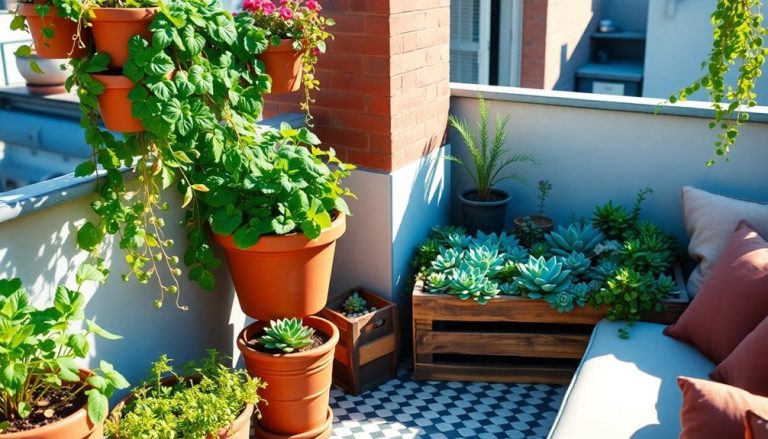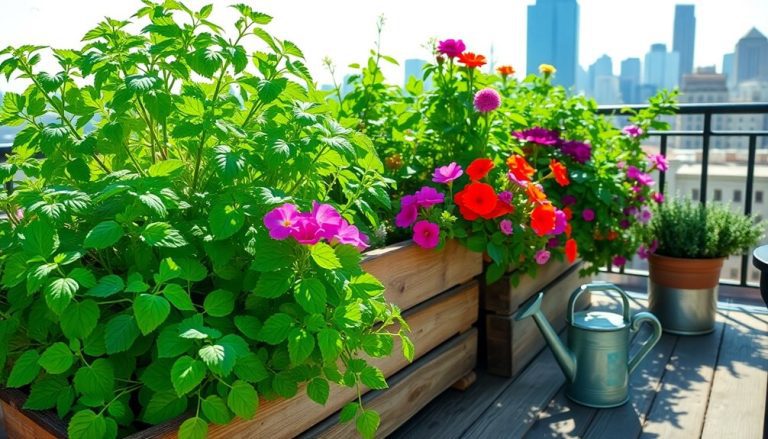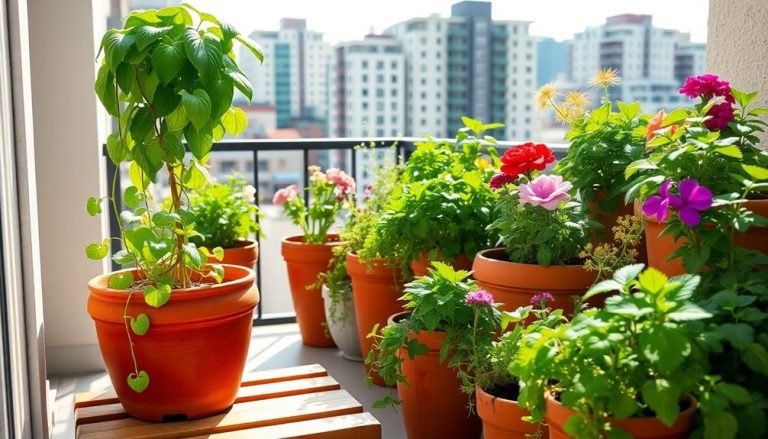To create an effective vegetable garden layout, pick a sunny location that gets 6-8 hours of sunlight daily. Ensure it's easily accessible and close to a water source. Plan your layout by placing taller plants to the north, allowing shorter plants to thrive. Consider companion planting; for example, pair tomatoes with basil to enhance growth and flavor. Implement crop rotation each season to maintain soil health and reduce pests. With these steps, you can simplify maintenance and maximize your harvest. There's plenty more to explore about each aspect for a thriving garden.
Key Takeaways
- Assess sunlight exposure to ensure each plant receives 6-8 hours of direct sunlight daily for optimal growth.
- Design pathways wide enough for easy access and to prevent soil compaction around the plants.
- Position taller plants to the north to avoid shading shorter plants, ensuring all receive adequate light.
- Group companion plants together to enhance growth and attract beneficial insects while avoiding competition.
- Implement a crop rotation plan to maintain soil health, prevent pests, and balance nutrient levels effectively.
Choosing the Right Location
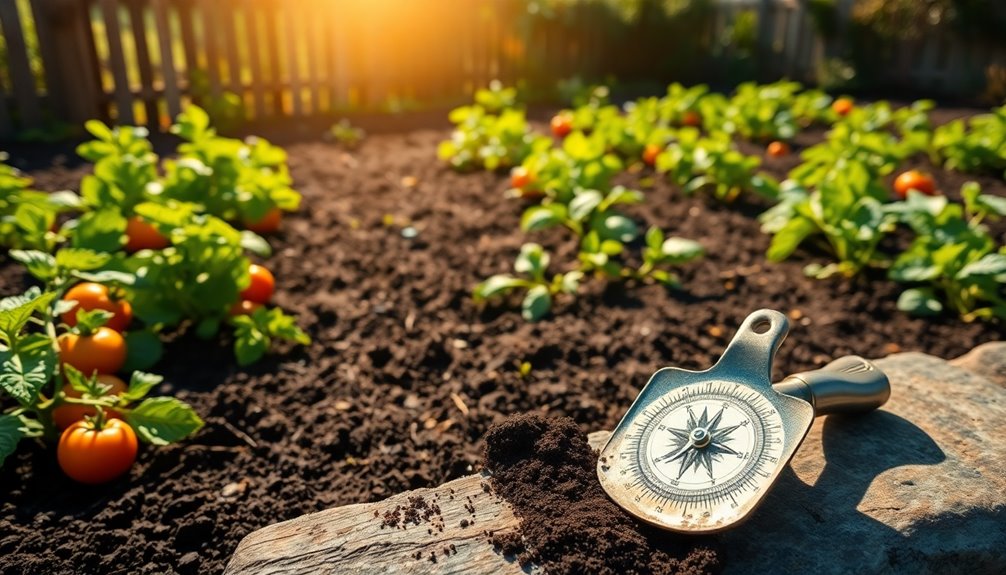
When it comes to choosing the right location for your vegetable garden, sunlight is key. You'll want a spot that gets at least six to eight hours of direct sunlight each day. This ensures your plants have the energy they need to grow strong and produce a bountiful harvest.
Take a stroll around your yard and observe how the sun moves throughout the day. Identify areas that stay sunny and consider how tall nearby trees or buildings might cast shadows.
Next, think about accessibility. You'll need a location that's easy to reach, so you can tend to your plants regularly. Make sure the spot is close to a water source for convenient irrigation.
Additionally, consider the soil quality in different areas of your yard. Well-draining soil is essential for healthy root development, so avoid spots where water tends to pool after rain.
Finally, keep in mind the wind and weather patterns. A sheltered area can protect your plants from harsh winds and unexpected storms.
Understanding Sun Exposure
Understanding sun exposure is crucial for the success of your vegetable garden. Plants need sunlight to photosynthesize, grow, and produce. Generally, most vegetables thrive with at least six hours of direct sunlight each day. So, you'll want to choose a spot that gets ample sun.
Start by observing your garden area throughout the day. Note how the sunlight shifts, as trees, buildings, or fences can create shade that affects your plants. Morning sun is particularly beneficial, as it warms the soil and dries dew, reducing the risk of disease.
Avoid areas that receive heavy afternoon shade since this can stunt growth. Consider the plant varieties you intend to grow. Some, like tomatoes and peppers, require full sun, while others, like lettuce and spinach, can tolerate partial shade. Adjust your garden layout accordingly, grouping plants with similar sun exposure needs together.
Lastly, think about seasonal changes; the sun's angle shifts throughout the year, so a spot that seems sunny in early spring may become less ideal in summer. By understanding these dynamics, you'll set your vegetable garden up for optimal growth and yield.
Planning Your Layout
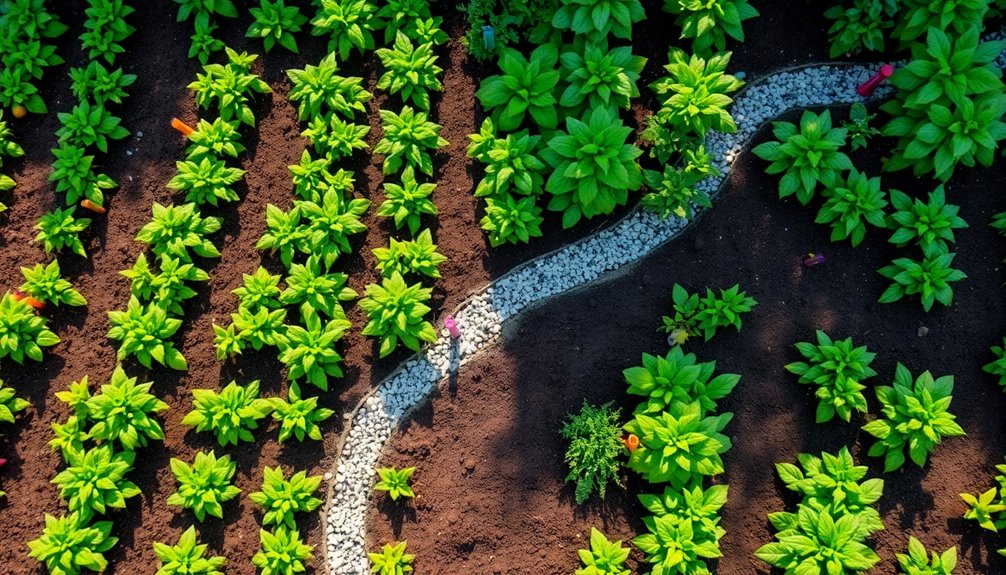
A well-thought-out layout is essential for maximizing your vegetable garden's productivity and ease of maintenance. By planning effectively, you can ensure your plants thrive and make your gardening experience enjoyable.
Here are some key factors to consider as you design your space:
- Sunlight: Position taller plants to the north to avoid shading shorter ones. This ensures every plant gets the sunlight it needs.
- Accessibility: Create pathways wide enough for easy access. You'll want to reach all your plants without stepping on the soil, which can compact it.
- Water Supply: Place your water source nearby. It'll save you time and energy when it comes to watering your garden.
- Plant Size and Growth Habits: Group similar plants together based on their growth patterns and sizes. This not only maximizes space but also helps in managing growth and harvesting.
Selecting Companion Plants
Selecting the right companion plants can significantly enhance your vegetable garden's health and productivity. When you choose plants that work well together, you can deter pests, improve growth, and maximize space.
Start by considering plants that naturally attract beneficial insects, like marigolds or nasturtiums, which can lure pollinators and predatory insects that feast on pests.
Next, think about mutual benefits. For example, planting basil alongside tomatoes can improve the flavor of your tomatoes and help repel harmful insects. Similarly, beans are excellent companions for corn, as they fix nitrogen in the soil, enriching it for their tall neighbor.
You'll also want to avoid planting species that compete for the same nutrients or space. For instance, planting onions and garlic near beans can inhibit their growth. Researching plant families can guide you in making wise choices that promote harmony in your garden.
Lastly, consider your garden's layout. Group compatible plants together to create a thriving ecosystem.
Organizing Planting Beds

Creating well-organized planting beds is crucial for maximizing your garden's potential. When you take the time to plan and structure your beds, you'll reap the rewards of a bountiful harvest. Here's how to get started:
- Define your space: Measure out your garden area and decide on the size of your planting beds. This helps you visualize and allocate space effectively.
- Choose your layout: Consider various designs like raised beds or traditional rows. Each has its benefits, so pick what suits your gardening style best.
- Group plants wisely: Organize your planting beds by grouping plants with similar water, light, and nutrient needs. This not only boosts growth but also simplifies maintenance.
- Leave pathways: Ensure you leave enough room between beds for easy access. This makes watering, harvesting, and weeding much less of a chore.
Implementing Crop Rotation
After setting up your planting beds, the next step is to think about how you'll manage your crops over time. Implementing crop rotation is essential for maintaining soil health and preventing pests and diseases. You'll want to rotate your crops each season, moving them to different areas of your garden. This practice helps balance nutrient depletion and reduces the risk of specific pests becoming established.
Here's a simple rotation plan you could follow:
| Season | Plant Type |
|---|---|
| Spring | Legumes |
| Summer | Nightshades |
| Fall | Brassicas |
Start with legumes in spring, as they fix nitrogen in the soil. In summer, plant nightshades like tomatoes and peppers, which thrive on the nutrients legumes have added. Finally, in fall, rotate to brassicas such as broccoli and kale, which can benefit from the enriched soil.
Maintaining Your Garden

While your vegetable garden may thrive during the growing season, maintaining it's crucial for ensuring long-term productivity and health.
Regular attention helps prevent pests, diseases, and nutrient depletion, allowing your hard work to flourish.
Here are four key maintenance tasks you shouldn't overlook:
- Water Wisely: Ensure your plants receive adequate moisture, especially during dry spells. Deep watering encourages strong root growth and resilience.
- Weed Regularly: Weeds compete for nutrients and water. Pull them out frequently to keep your garden space clean and your vegetables thriving.
- Mulch: Applying a layer of mulch around your plants conserves moisture, suppresses weeds, and adds organic matter to the soil as it breaks down.
- Monitor for Pests: Stay vigilant for any signs of pests or diseases. Early detection allows for quick intervention, protecting your plants from severe damage.
Frequently Asked Questions
What Tools Are Essential for Starting a Vegetable Garden?
To start your vegetable garden, you'll need essential tools like a spade, trowel, hoe, rake, and watering can. Don't forget gloves and seeds to ensure your gardening experience is enjoyable and productive right from the start!
How Much Water Do Vegetables Typically Need?
Vegetables typically need about one inch of water per week, either from rainfall or irrigation. You'll want to adjust this based on your climate and soil type, ensuring your plants stay healthy and productive.
When Is the Best Time to Plant Seeds?
The best time to plant seeds depends on your region's climate. Generally, you should plant after the last frost date in spring. Check local guidelines to ensure optimal growth and avoid setbacks from cold weather.
How Do I Protect My Garden From Pests?
You wouldn't believe how quickly pests can ruin your hard work. To protect your garden, use natural repellents, introduce beneficial insects, and maintain healthy plants. Regular monitoring and timely interventions keep those pesky invaders at bay!
Can I Start a Vegetable Garden in Pots?
Yes, you can definitely start a vegetable garden in pots! Choose the right containers, ensure proper drainage, and select suitable vegetables. With care and attention, you'll enjoy a thriving garden right on your patio or balcony.
Conclusion
In the grand tapestry of your vegetable garden, each step you take weaves a story of growth and harmony. By choosing the right spot and planning your layout, you're not just planting seeds; you're nurturing a vibrant ecosystem. With companion plants and thoughtful organization, your garden will flourish like a well-rehearsed symphony. Embrace the gentle rhythm of crop rotation and garden maintenance, and watch as your green sanctuary thrives, bringing joy and sustenance into your life.


